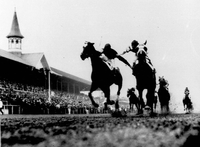Dr. Doyle G. Meadows, Professor University of Tennessee
Conformation of the Tennessee Walking Horse is directly related to skeletal structure. It includes the bones and ligaments which bind the bones together to form joints. The skeletal structure provides the framework that gives the body shape and protects the vital organs. The skeleton of the horse will determine the length and slope of shoulder, overall height and length, length of back and all the other things that are related to skeletal design.
Generally, the skeletal structures that receive the most attention are the feet and legs. It is obvious that a horse must have structurally correct legs to be a performance athlete or to provide pleasure to its owner. The manner in which a horse moves is determined by the horse's conformation and skeletal structure. The usefulness of Tennessee Walking Horses depends on their ability to move and perform in an appropriate manner.
Front Legs - Front View
The horse's forelimb bears about 65 percent of the weight of the horse. It is, therefore, extremely important to have straight, structurally correct front legs. Due to the amount of weight on the forelimb, there are more front leg injuries as a result of trauma and concussion. It is important to have proper bone length and angle to achieve proper horse conformation (Figure 2).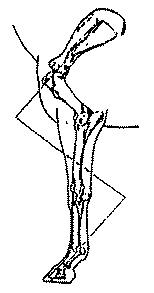
Figure 2. Front column of bones as viewed from the side. Source: Stashak, Ted S. Adams Lameness in Horses. Fourth Edition. 1987.
As viewed from the front, a straight line from the point of the shoulder should bisect the entire front leg all the way to the toe. There should be two equal parts in the ideally structured horse. Although this is actually rare, the toes and knees should point straight forward. Additionally, the width of the toes on the ground should be the same width as their origin in the chest. The cannon bone should be centered on the knee and fetlock (Figure 3).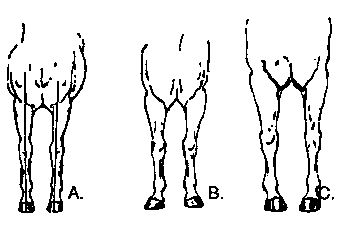
Figure 3. Front leg as viewed from the front: A) Ideal, B)Toes-out (splay footed) C) Toes-in (pigeon toed). Source: Heird, J.C. A Guide for Successful Competitive Horse Judging. Colorado State University, Animal Reproduction and Biotechnology Laboratory. Bulletin No. 07. 1992.
There are several deviations to the ideal front column of bones as viewed from the front. Any deviation from the normal has the potential to affect movement and, subsequently, performance. Horses whose toes point inward (toed-in) are referred to as "pigeon-toed" while horses that have toes that point outward (toes-out) are called "splay-footed" (Figure 3). Foot flight patterns are shown in Figure 4.
tennessee walki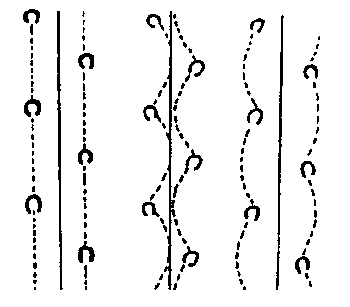
Figure 4. Way of Going: (A)Normal foot moves in a straight line, (B)"Base-wide," or "Toed-out" feet move forward in inward arcs, "Winging", (C)"Base Narrow," or "pigeon toed" feet move forward in wide outward arcs, "Padding." Source: Heird, J.C. A Guide for Successful Competitive Horse Judging. Colorado State University, Animal Reproduction and Biotechnology Laboratory. Bulletin No. 07. 1992.
An additional structural deviation in the front leg is base-narrow (Figure 5). This condition is indicative of a horse whose feet stand closer at the ground than at the origin of the legs in the chest. This is typical of horses with larger muscle mass. The base-narrow horse is predisposed to landing on the outside of the hoof wall. Due to the extra weight placed on the outside of the hoof, horses develop conditions such as ringbone, sidebone and heel bruising. Horses with this conformational problem can either toe-in or toe-out.
tennessee walking horse, tennesse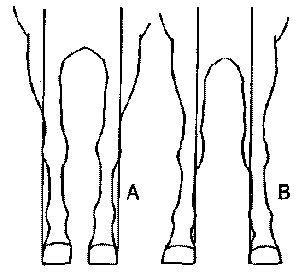
Figure 5. Front leg view: Base narrow. Front leg view: Base wide. Source: Stashak, Ted S. Adams Lameness in Horses. Fourth Edition. 1987.
Base-wide conformation positions the feet of the horse at the ground wider than their origin at the chest (Figure 5). This condition is seen in many narrow-chested horses and is usually accompanied by feet that toe-out. Unlike the base-narrow horse, this condition allows more weight to be distributed to the inside of the horse's hoof. Horses that are base-wide are also predisposed to ringbone and sidebone.
Bowlegs, knock-knees and bench knees are examples of poor conformation that may affect soundness (Figure 6).
tennessee walking horse, tennes
Figure 6. Front leg structural faults: A)Bowlegs, B)Knock-knees, C)Bench knees. Source: Stashak, Ted S. Adams Lameness in Horses. Fourth Edition. 1987
Bowlegged horses present the entire knee in an outward deviation as viewed from the front. This condition causes increased tension on the outside of the leg due to the unequal distribution of concussion and force. Knock-kneed or close-kneed horses have the entire knee set to the inside of a straight line from chest to toe. This condition is generally accompanied by horses being toed-out and with some degree of outward rotation of the cannon and fetlock. Again, this condition is predisposed to unsoundness due to an unequal line of concussion.
Bench knees are another structural fault in horses. Bench or offset knees are characteristic of a horse with the cannon bones set too far to the outside of the knee. This conformational problem increases the possibility for horses to develop splints (Figure 7).
tennessee walking horse, tennessee walking horse, 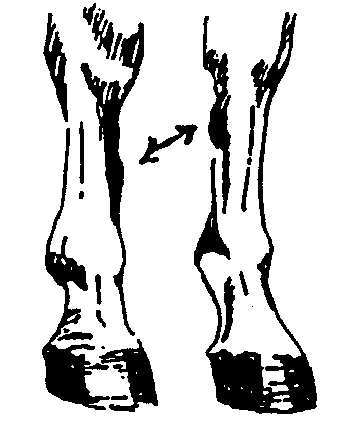
Figure 7. Splints are bony enlargements in the groove formed by the splint and cannon bone. They may be high or low, forward or back.
Front Legs - Side View
The front column of bones as viewed from the side should have appropriate slope and angle of shoulder and pastern. Additionally, a vertical line should run from the center of the scapula to the front edge of the knee and bisect the hoof as shown in Figure 8.
tennessee walking horse, tennessee walking horse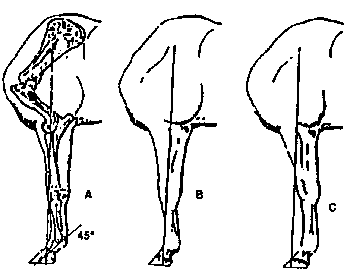
Figure 8. The front legs, side view: A)Ideal, B)Buck-kneed, C)Calf-kneed. Source: Stashak, Ted S. Adams Lameness in Horses. Fourth Edition. 1987.
Some horses are camped-under in front. This condition refers to a horse whose forelimb is too far under the body (Figure 9). This camped-under effect will prevent a horse from having a long fluid stride and predisposes horses to unsoundnesses. These horses typically have excessive wear on the hoof with an increase in pressure on ligaments and tendons.
tennessee walking horse, tennessee walking horse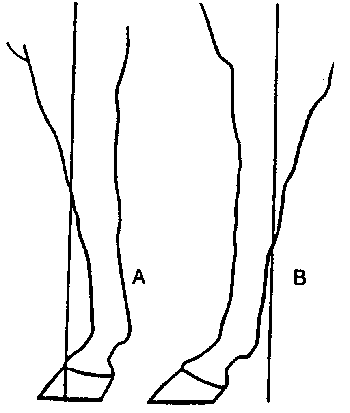
Figure 9. Front leg as viewed from the side: A)Camped-under, B)Camped out. Source: Stashak, Ted S. Adams Lameness in Horses. Fourth Edition. 1987.
Camped-out refers to horses whose entire forelimb is too far forward and away from the body (Figure 9). These horses will have excessive concussion and stress on the knees, ankle and hoof. These horses are predisposed to navicular disease and laminitis. Ideal position of the front leg in relationship to the body is shown in Figure 8.
Two primary structural deviations exist in the knees of as horses as they are viewed from the side. The most frequent condition is "over at the knees" or commonly referred to as buck-kneed (Figure 8). This is a forward deviation of the knee set too far forward in the horse's leg. Although a structural deviation from the normal, buck-kneed horses are capable of a long performance life.
The opposite condition to buck-knees is "back at the knees" or calf kneed (Figure 8). This conformation fault is extremely serious and many calf-kneed horses do not stay sound. This condition positions knees that are set behind or back in the horse's leg. Calf-knees allow the knees to bend backwards (hyperextend) and predispose the horse to unsoundness.
tennessee walker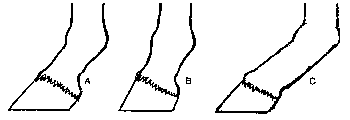
Figure 10. Pastern conformation: A)Ideal, B)Short and steep, C)Long and weak.
Ideal pastern conformation places the angle of the pastern at approximately 45 degrees in front and approximately 50 degrees in the rear pastern, with a moderate length to the pastern (Figure 10). Short, steep pasterns will not allow for the normal "cushion" effect on the forelimb that is found in the ideal. This condition gives a choppy, rough stride that is predisposed to lameness due to extra concussion on the entire front column of bones. Long, weak pasterns allow the horse to injure ankles, tendons and ligaments because the pasterns are too long relative to length of limb.
Rear Legs - Rear View
Ideally, when viewing a horse from the rear for structural correctness, you should draw an imaginary line from the point of the buttocks to the ground which should bisect the gaskin, hock and hoof (Figure 11). This will provide equal distribution of weight, equal bone pressure and equal strain on ligaments. It is not critical that a horse be perfectly straight from the ankles down as viewed from the rear. In fact, most horses naturally stand with the cannons parallel and toe out slightly from the ankles down. This allows a horse's stifle to clear the rib cage in flight, resulting in a longer-strided, freer-moving horse.
tennessee walking horse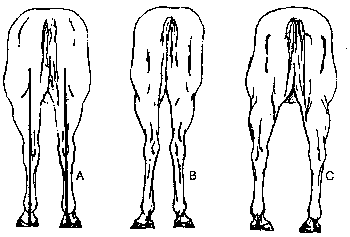
Figure 11. Structure of the hind limb as viewed from the rear: A)Ideal, B)Cow-hocked, C)Bow-legged. Source: Heird, J.C. A Guide for Successful Competitive Horse Judging. Colorado State University, Animal Reproduction and Biotechnology Laboratory. Bulletin No. 07. 1992.
Horses that are bowed-in at the hocks, with the cannon bones not parallel, are referred to as "cow-hocked" (Figure 11). Typically, these horses have hocks that are too close, point toward one another and the feet are widely separated. These horses have hind limbs that are base-narrow from the buttocks to the hocks and base-wide from the hocks to the toes. The horse that is "cow-hocked" will have a tendency to be weak in the major movements that require work off the haunches such as stopping, turning and sliding.
Occasionally there are horses that actually toe-in behind and are "out at the hock" (bow-legged). Bow-legged horses (Figure 11) have hocks that are too far apart and are generally predisposed to being base-narrow. These horses have added strain on the bones, ligaments and joints and may have many types of interference in movement. Most of these horses are very poor athletes and should be severely penalized.
Rear Legs - Side View
Conformation excellence of the horse's hind leg structure as viewed from the side is indicated by a line from the point of the buttocks to the ground. Ideally, that line should touch the hocks, run parallel to the cannon and be slightly behind the heel (Figure 12). A horse with too much angle in the hock joint is sickle-hocked. As viewed from the side, the horse is standing under from the hock down, due to the excessive angulation in the hock (Figure 12). Horses with sickle hocks are predisposed to curbs, enlargements below the point of the hock. Many of these horses tend to be outstanding athletes for a brief period of time.
tennessee walking horse, tennessee walker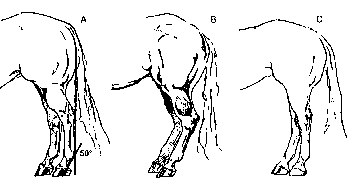
Figure 12. Structure of the hind limb as viewed from the side: A)Ideal, B)Sickle-hocked, C)Post-legged. Source: Heird, J.C. A Guide for Successful Competitive Horse Judging. Colorado State University, Animal Reproduction and Biotechnology Laboratory. Bulletin No. 07. 1992.
Excessively straight-hocked horses have correspondingly less set (or angle) in the hock joint (Figure 12) and are referred to as post-legged. These horses typically have poor movement, with little flexion, which causes limited drive and impulsion from their hind leg. This predisposes the horse to bog spavins, inflammation or swelling of the soft tissue of the hock, and increases the chance for injury and unsoundness.
Summary
Structural correctness ultimately determines the value and usefulness of a horse. Regardless of whether the horse is a favorite at the Celebration or a youth's pleasure mount, length and angle of the bone structure combined with skeletal correctness play a critical role in the usefulness of the athlete. As the number and severity of structural problems increase, the expected life, activity and performance of the horse are severely limited.
References:Stashak, Ted S. Adams Lameness in Horses. Fourth Edition. 1987.
Heird, J.C. A Guide for Successful Competitive Horse Judging. Colorado State University, Animal Reproduction and Biotechnology Laboratory. 1992.
http://www.legacyspottedwalkers.com/TWH_STRUCTURE.htm
Trackback URL : 이 글에는 트랙백을 보낼 수 없습니다
Trackback RSS : http://www.fallight.com/rss/trackback/1344
Trackback ATOM : http://www.fallight.com/atom/trackback/1344
